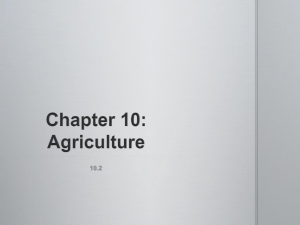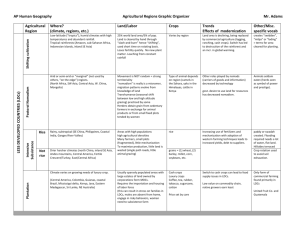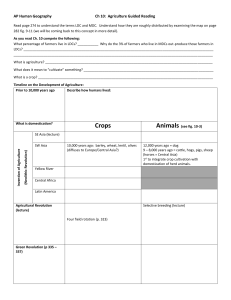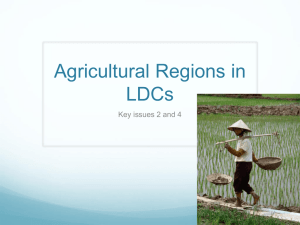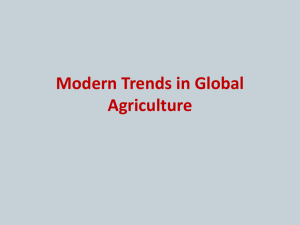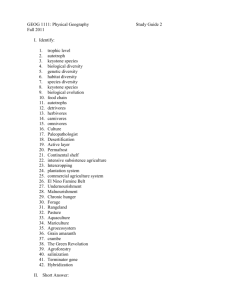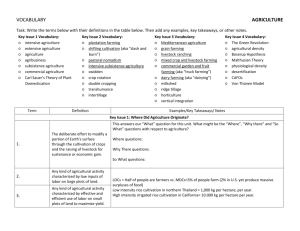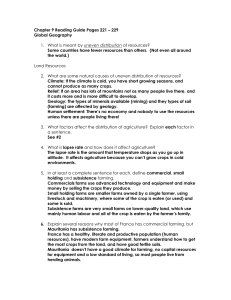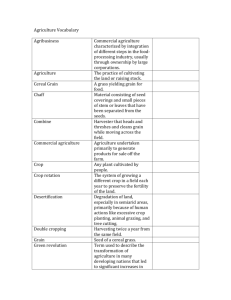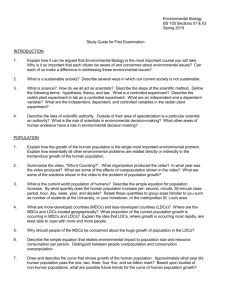Agriculture - Faculty Web Pages
advertisement
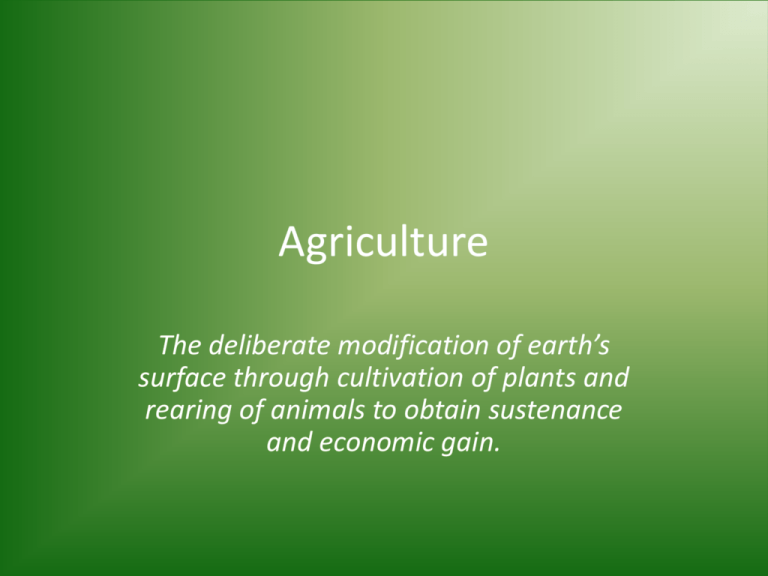
Agriculture The deliberate modification of earth’s surface through cultivation of plants and rearing of animals to obtain sustenance and economic gain. Hunting and Gathering Hunting Fishing Gathering plants, nuts, or berries Small groups <50 Nomadic Gender division of labor Men hunt Women gather Still ¼ million hunters and gatherers in isolated locations worldwide! Invention of Agriculture • Observation of seeds growing, effects of water and natural fertilizer • Accidental or deliberate experiment? • Women were gatherers – role in domestication? • Domesticated animals for protection, pets, and food • Prehistoric (before recorded history) Multiple Origins Theory • Hearths – places of origin • Multiple independent hearths – Food produced in distinctive ways in different regions – Based on local wild plants and animals, climatic conditions, and cultural preferences • Diffusion to other areas through contact – Dependent on where particular plants and animals thrive Vegetative Planting and Seed Agriculture Carl Sauer’s Theory Vegetative Planting • Cutting stems and dividing roots • Southeast Asia • Taro, yam, banana, palm • Fishing was main food source, so more sedentary Seed Agriculture • Annual planting of seeds • Practiced by most farmers today • Eastern Hemisphere – Southwest Asia: wheat, barley • Raised cattle, sheep, goats that were also used to plow – China: soybean – Africa: coffee, cotton • Western Hemisphere – Mexico: maize, beans, squash – Peru: potato Agriculture Today • Subsistence Agriculture: production of food primarily for consumption by the farmer’s family or village – LDCs • Commercial Agriculture: production of food primarily for sale off the farm – MDCs Agricultural Regions Subsistence Agriculture • Shifting cultivation • Pastoral Nomadism • Intensive Subsistence, Rice Dominant • Intensive Subsistence, other than rice dominant • Plantation Commercial Agriculture • Mixed Crop and Livestock • Dairying • Grain • Ranching • Mediterranean • Commercial Gardening Agricultural Regions Note the locations of each type of agriculture Climate Influences on Agriculture •Pastoral Nomadism: dry climates •Shifting Cultivation: tropical wet climates •Crops take more water than grazing •Some crops take less water, like wheat •Some crops need a long growing season, like cotton Rural Settlements • Clustered: agricultural community with families and public building together and fields surrounding the settlement – New England – irregular shaped fields – Linear – French Long Lots – Circular – Masai, early Europe • Dispersed: farmers live on individual farms isolated from neighbors – Modern North America Masai Kraal – animal “corral” in center, houses surrounding it with gardens, grazing area or fields outside Comparing Subsistence and Commercial Agriculture Subsistence • High percentage of farmers – 50% or more in LDCs • Small farms – LDCs average size 1,7 acres • Few machines – LDCs have abundant labor force – Machinery too expensive Commercial • Low percentage of farmers – Less than 10%, U.S. only 2% • Large farms – U.S. average size 444 acres • Many machines – High capital investment – Tractors, combines, milking machines – Refrigeration, transportation – Fertilizers, pesticides Labor Force Engaged in Agriculture Tractors per 1000 Hectares of Cropland Subsistence Agriculture Regions • LDCs • Type of agriculture dependent on climate – Shifting Agriculture in wet lands – Pastoral Nomadism in dry lands • Asia’s large population clusters practice intensive subsistence agriculture – Areas of abundant rainfall Shifting Cultivation • Also called “slash-and-burn” or “swidden” • Tropical rainforest areas –warm, wet – South America, Southeast Asia • Burning releases natural fertilizer in the ash • Only good for about 3 years – Rains leach out nutrients, no new decaying plants – Villagers move to another location Brazil Pastoral Nomadism • Herding of domesticated animals – Transhumance: moving with the seasons • Dry regions (arid and semiarid) – Africa, Middle East, Central Asia – Bedouins: camels, Masai: cattle • Meat, milk, hides from animals – Grain consumed as well, products from trade – Number of animals is measure of wealth • 15 million people today , 20% of earth’s land Masai Intensive Subsistence • Areas of high agricultural density – Ratio of farmers to arable land is high – Small farms must feed a lot of people – East Asia, South Asia, Southeast Asia • Work by hand or with animals • Wet rice: seedling started in nursery, later moved to flooded fields by hand – Flat “paddies” or terraced hillsides • Other crops and animals raised besides – “Chinese system” – carp, ducks, pigs, vegetables, fruit Rice Production Plantation • Large farm specializing in one or two crops – Cotton, sugar cane, coffee, rubber, tobacco • Tropics or Sub-Tropics – Warm, wet climate – Latin America, Africa, Asia – U.S. South prior to Civil War with slave labor • Located in LDCs, but owned by MDCs – Crops grown for sale in MDCs – Often low pay for workers – Actually commercial agriculture in regions of subsistence agriculture Malaysian Tea Plantation Commercial Agriculture Regions • • • • • • • Six main types Found in MDCs Influenced by physical geography (climate) Large farms/ranches Low percentage of farmers in population High usage of machinery For sale in the market in MDCs Mixed Crop and Livestock • Corn most common crop, then soybeans – Fed to livestock – Crop rotation Corn Production Dairy Farming • Located near urban areas in MDCs – For rapid transport to market • Highly mechanized and controlled – Use of milking machines – Use of growth hormones • Milk production in LDCs is growing – Higher standard of living can buy more milk Milk Production World Milk Production Grain Farming • Sometimes called cereal crops • Usually located in areas too dry for mixed crop and livestock • Plains states in the U.S . – large farms • Grown primarily for consumption by humans • Wheat is the most important in U.S. – Can grow in dry areas, can be “double-cropped” – Completely mechanized from plowing to harvesting • Grain is the least labor-intensive type of farming Wheat Production Livestock Ranching • Ranching: the commercial grazing of livestock over an extensive area – MDCs have very large herds on enormous ranches • U.S. , Argentina, and Brazil – cattle • Australia, British Isles – sheep • Arid or semi-arid land where soil is too poor or water too scarce to support crops • Now part of the meat processing industry – Not the romantic days of the cowboys driving the Texas herds up north to market! Meat Production Commercial Gardening and Fruit Farming • U.S. southeast, warm and wet • “Truck farming” – from old English word for barter • • • • Vegetables Fruits, nuts, citrus orchards High value, small quantities Small farms Peanut Crop Mediterranean • Like California! Or Italy . . . • Mediterranean Climate – Hot dry summers, cool wet winters – Only 5 places in the world have this climate • Mediterranean Basin, California, Chile, Southern Australia, and Capetown, South Africa – All are wine producers, so look at Trader Joes • Hilly land • Grapes and olives, wine – Many other crops if water is available – Bread and Wine culture – wheat in hot/dry climate Vineyard Olive Groves Subsistence Agriculture and Population Growth Four strategies to increase food production 1. Expand agriculture Only 11% of earth’s land now cultivated 2. Increase productivity Green Revolution: miracle crops (high yield), expand use of fertilizer and pesticides 3. Identify new food sources Acceptance, cultural preferences, hybrids 4. Expand exports MDCs exporting more to LDCs Africa is facing strong challenges to produce enough food for its growing population World Agricultural Land Grain Imports and Exports Daily Calories Consumed per Person Africa’s Food Supply Crisis Overuse of land has led to desertification, the permanent destruction of arable land as it is overtaken by the desert. At the same time, the population is growing rapidly, leading to famine. VON THÜNEN’s MODEL Commercial Agriculture and Market Forces • Agribusiness – commercial farming in MDCs – Includes tractor mfg, fertilizer prod, seed dist – Controlled by large corporations • Food production has increased in MDCs but demand has remained the same – Leads to low prices, market saturation • Government subsidies – Paid to leave fields fallow (not planted) – Paid if prices are too low – Donated to foreign government or given to low-income Americans – Agricultural Dumping – negative result of subsidized agriculture in MDCs, puts poor farmers out of business in LDCs Agribusiness: Dairy Farming Fewer cows now in U.S., but milk production is higher. Yield per cow tripled since 1960s. Good or bad? Sustainable Agriculture • Sensitive land management – Ridge tillage to reduce erosion • Limited use of chemicals – Mechanical weed control instead of pesticides • Integrated crop and livestock – Animals consume crops grown on the farm reducing transportation expense and leaving animals to graze naturally, fewer crowded pens • Organic farming – how to define and identify – Sustainable agriculture at its best!
